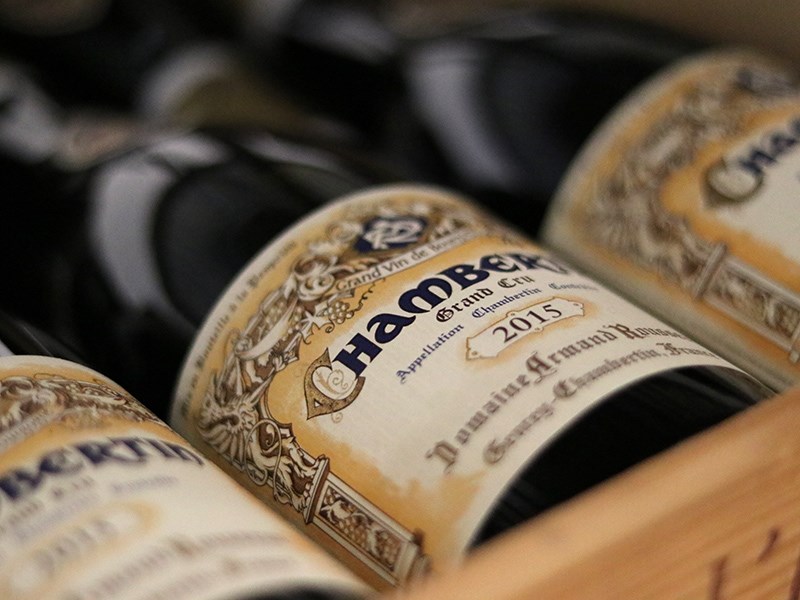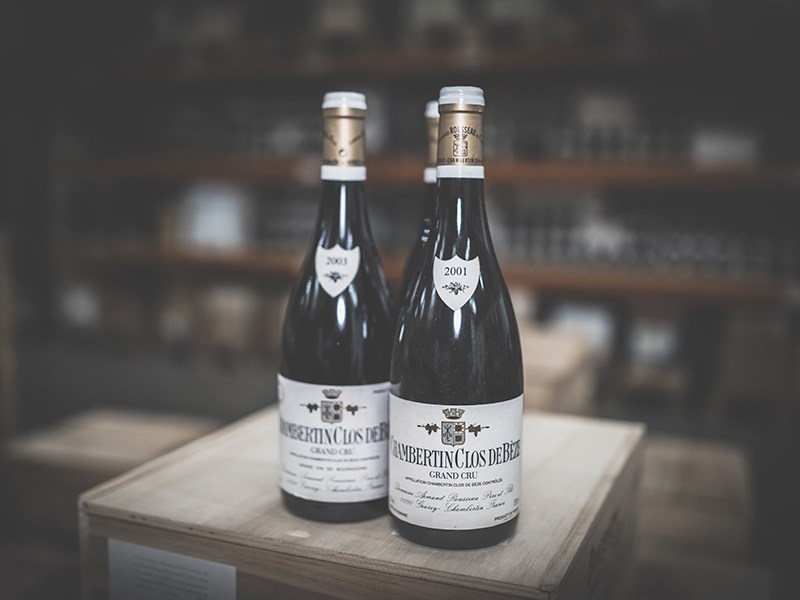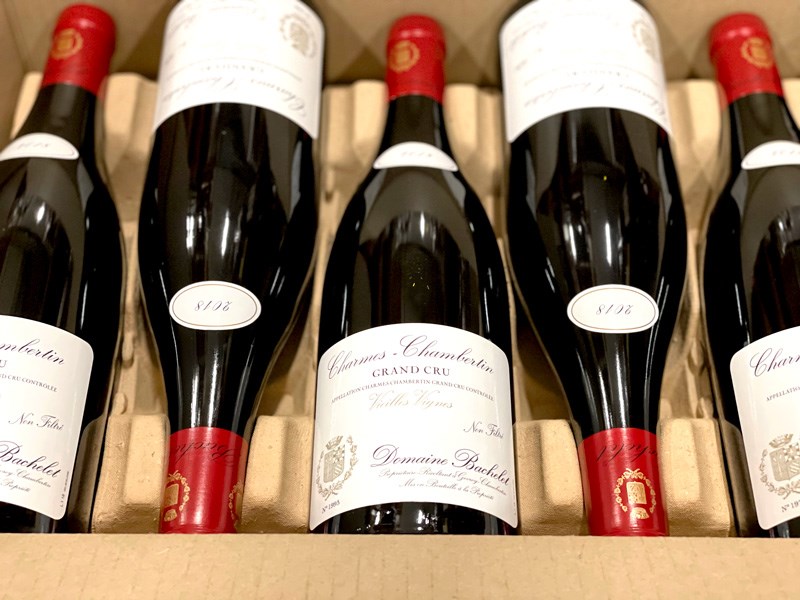Article - RareWine Academy
Gevrey-Chambertin: Home Of World Reputation, Complexity, And Beautiful Wines With Backbone.
Five appellations dominate in Burgundy. This article explores Gevrey-Chambertin, where some of the world's best wines are made.
"I forgot the name of the place, I forgot the name of the girl, but the wine was a Chambertin!"
- Hilaire Belloc
The Big Five In Burgundy
Burgundy is home to some of the world's very best wine producers. Burgundy is magical. And Burgundy is complex. To get a better overview of Burgundy and the very best red wines from here, you need to zoom in. The entire Burgundy region measures 230 kilometres from Chablis in the north to Macon in the south. Focusing on the Cote d'Or – the golden slope – the size is reduced to 65 kilometres.
On the golden slope, the northern Cote de Nuits occupies 25 kilometres of the 230 kilometres, and these can be further reduced to a stretch of just 10 kilometres, where the best appellations are situated. Their location is perfect, even if the area is extremely minimal. Wines from here therefore come in very high quality and extremely limited quantities.
This series of articles focuses on the five main appellations: Gevrey-Chambertin, Morey-Saint-Denis, Chambolle-Musigny, Vougeot and Vosne-Romanée. Soil and exposure are highlighted, and the main Grand Cru and Premier Cru vineyards are highlighted.
Gevrey-Chambertin
Gevrey-Chambertin is the first of the famous appellations you come to, when you come from the north. From Dijon, you drive about 10 kilometres through the first northern vineyards of Fixin and Marsannay before you reach the appellation border. Gevrey-Chambertin is in many ways the largest appellation. It measures around 500 hectares, of which more than 80 are classified as Grand Cru. In total, the commune has 9 Grand Cru vineyards and as many as 26 Premier Cru vineyards.
In terms of taste, Gevrey-Chambertin is often referred to as the King of Burgundy. When compared to the other major communes for red wine, the wines from Gevrey-Chambertin generally have a higher level of tannin and acidity, giving more backbone to the wine. In recent years, however, some producers have changed winemaking techniques, so that the wines have become lighter and more airy in their expression.
Of course, not all vineyards have exactly the same soil and do not deliver the same grapes to the cellar. As a result, winemakers express each terroir differently. That is why the wines from here range from the most intense to the most beautifully airy wines.

Soil And Exposure In Gevrey-Chambertin
Gevrey-Chambertin is perfectly situated on the golden slope, and the location of the nine Grand Cru vineyards is textbook material for understanding exposure. The vineyards are located where the soil has collected the right minerals, and the slope towards the sun is optimal – precisely here exists the right composition of stones, gravel, and sand.
The whole appellation is dominated by the valley that comes from the western side of the slope and cuts through to Gevrey-Chambertin. A river used to run here, which is now more of a valley. In this valley, sediment has been deposited over time on both sides. On the northern side, there is a range of vineyards with Premier Cru status, known as Cote de Jacques. These are at the very highest level of their classification.
The rest of the appellation is covered by Village-appellation vineyards on both sides of the main road. Normally, there would not be so many vineyards on the other side of the main road, but here, the deposits of stones from the valley extend further than in many other places along the golden slope. In general, however, the wines from vineyards on the other side of the road are often lighter and have less ageing potential. A large vineyard like La Justice produces wines that taste good from an early stage. The best village vineyards, such as Les Evocelles, are at the level just below Premier Cru.
"Nothing makes the future look brighter than looking at it through a glass of Chambertin"
- Alexandre Dumas
Grand Cru In Gevrey-Chambertin
There are nine vineyards classified at Grand Cru level in Gevrey-Chambertin, which is the highest level in Burgundy. They are all lined up just south of the town on the perfect slope. It rises from 260 - 300 metres above sea level, where they are located. This helps to ensure a reasonable drainage of the vineyards as well as a good elevation, giving better exposure to the sun. The two best vineyards are Chambertin and Chambertin Clos de Beze. Historically, these two vineyards were not separated, so when the appellation was made in 1935, wines from Clos de Beze were allowed to be bottled as Chambertin if the producer preferred to do so. This is still allowed in theory, but not many do it. Next are the other vineyards, all of which are allowed to use Chambertin as their surname. In total, more than 80 hectares are classified as Grand Cru.
Chambertin Grand Cru
Here, we are at the absolute top level in Burgundy. The Chambertin vineyard not only provides grapes for red wine, it provides the material from which dreams are made. When the best vineyards in Burgundy are mentioned, Chambertin is put at the top along with Romanée-Conti and Musigny. These three are a level above the other Grand Cru vineyards.
Chambertin Grand Cru is the most famous and certainly the best exponent of the style of Gevrey-Chambertin. It produces beautiful, structured wines with a good ageing potential. In total, 12.9 hectares are classified as Chambertin, and the vineyard, together with the vineyards planted from the forest, lies down towards the road with a gentle slope from 280 - 240 metres in altitude.
Armand Rousseau is the largest landowner with 2.56 hectares, followed by Domaine Trapet with 1.9 hectares.
The best producer in the vineyard must be the legendary Domaine Leroy with its 0.5 hectares and a location right in the middle. Rousseau is also at the absolute top with his Chambertin, which is composed of parcels from several different locations on the vineyard.
Chambertin – Clos de Beze
Chambertin - Clos de Beze is located in the immediate extension of Chambertin. The 15.4 hectares of vineyard have greater variations in soil than Chambertin itself. The slightly higher proportion of dark marl at the northern end makes the wine slightly heavier.
The largest landowner is Pierre Damoy with 5.36 hectares. He produces a powerful age-worthy Chambertin - Clos de Beze in a style that requires time to open up the full spectrum of fruit. Next comes Drouhin-Laroze with a fine wine from its 1.54 hectares.
Bruno Clair and Prieure-Roch produce two of the most coveted examples of Clos de Beze from each of their approximately one hectare of land.
Chapelle-Chambertin
Chapelle-Chambertin is just below Clos de Beze a little further down the slope, which gives a slight slope on the vineyard itself. This vineyard has a very thin top layer of soil, which can make it difficult in dry vintages, although this is turned to advantage in wet vintages. In total, the vineyard covers 5,49 hectares, divided into a northern and southern part. The southern part, Les Gémeaux, first became part of the estate in 1936.
Pierre Damoy is also the largest landowner here with 2.22 hectares spread over both parts of the vineyard.
It is Cecile Tremblay and Domaine Ponsot who make the greatest wines from here.
Charmes-Chambertin And Mazoyeres-Chambertin
These two vineyards can both be marketed with Charmes-Chambertin on the label, which is much easier to pronounce than Mazoyeres, which is why many producers prefer the word Charmes. Most producers prefer this option as Mazoyeres is less famous than the greater Charmes-Chambertin. Few producers choose to bottle with Mazoyeres on the label unless they own parcels in both and wish to bottle them separately. The last phenomenon is seen in the case of Dugat-Py and Perrot-Minot. Overall, the vineyard is almost 30 hectares with a preponderance for Mazoyeres-Chambertin.
The part called Charmes-Chambertin lies directly below Chambertin and starts at the same altitude and on the same soil as Chambertin itself. The quality of the wines from Charmes-Chambertin is considered to be slightly lower than Chambertin.
The Mazoyeres part extends far down to the main road itself - much further down the slope than usual with Grand Cru. However, the soil is virtually the same throughout the whole vineyard, but the flatter part of the vineyard closest to the main road produces wines of lower quality.
The largest total landowner is Domaine Camus, which with 6.9 hectares has the potential to produce even better wines than they are known for today.
The top producers here are Armand Rousseau, Dugat-Py and Roumier.

Griotte-Chambertin
Griotte-Chambertin is the smallest of the Grand Cru vineyards in Gevrey-Chambertin. With only 2.73 hectares, not much more than 1000 cases of wine come from the six marquis combined. These are very elegant wines with great floral aromas.
The largest landowner is Laurent Ponsot with 0.89 hectares, and he is also considered one of the best exponents from here.
Latricieres-Chambertin
Latricieres-Chambertin is the last pearl in the line to the south and in direct continuation of Chambertin. Here, the vineyard is less sloping, and the soil is slightly lighter. With 7.35 hectares, it is a vineyard of considerable size and delivers a very fine and elegant style. Several producers talk about this often being the first of their Grand Crus they bottle from Gevrey.
With 1.51 hectares, Hubert Camus is the largest landowner. The most prominent name is Domaine Leroy with 0.57 hectares, followed by Ponsot and Trapet.
Mazis-Chambertin
Mazis-Chambertin is located in the far north and the first vineyard at the exit from the town on the small country road. With 9.10 hectares, there is a difference in the quality of this vineyard.
The largest landowner here is Hospice de Beaune with 1.75 hectares, which is one of their most famous red wines. The wines of Hospice de Beaune are sold every year at the famous auction in Beaune, which is the guiding factor for the price structure in the area. Domaine Faiveley owns 1.56 hectares and also stands as a good exponent here in the vineyard.
Most famous again is Madame Lalou Bize-Leroy. Leroy owns a parcel of only 0.26 hectares, and she produces under the name Domaine d'Auvenay instead of Domaine Leroy. D'Auvenay is the farm where she lives.
Ruchottes-Chambertin
Ruchottes-Chambertin is the last and second smallest Grand Cru in Gevrey-Chambertin. The 3.3 hectares are located up the slope from Mazis but are still divided significantly. Armand Rousseau owns 1.06 hectares on the upper part of the vineyard, called Clos des Ruchottes, and is an excellent exponent of the appellation. He is considered the best producer along with Roumier, who produces a wine from his 0.54 hectares.

Premier Cru In Gevrey-Chambertin
There are two groupings of Premier Cru vineyards in Gevrey-Chambertin. With the increasing interest in the best wines of Burgundy, there is more and more focus on the next level, Premier Cru. These wines have been available for a number of years at reasonable prices – in the future prices are expected to increase.
The largest group of Premier Cru vineyards is located at the northern end of the commune just at the end of the valley from the west. Here is the slope better known as Cote de Jacques with several famous vineyards. At one point, producers tried to have these classified as their own appellation but were unsuccessful. There are others who believe that the level of the best vineyards here - especially Clos Saint Jacques - is so high that it could be classified as Grand Cru. Most likely, they will remain Premier Cru under the current appellation.
The second group of Premier Cru vineyards is around the nine Grand Cru vineyards, which is quite normal. Where the soil has the best composition and exposure, there is Grand Cru - right next to it will often be Premier Cru.
Clos Saint-Jacques
Clos Saint Jacques is considered to be the best Premier Cru in the commune. It is often mentioned together with Les Amouresses and Cros Parantoux as the best Premier Cru vineyards in Burgundy. The vineyard itself measures 6.7 hectares in total, and there are currently five owners, all of whom make excellent wine from it. At Armand Rousseau, they rank this vineyard on a par with their Grand Cru wines in both reputation and price. Rousseau holds the largest piece of land at 2.22 hectares.
Les Cazetiers
Les Cazetiers is the neighbour of Clos Saint Jacques and the best parts of its 9.12 hectares are close to the same high level. Domaine Faiveley owns most of the land with 4.06 hectares, from which they produce a really nice, structured wine. There are several good examples with stable high quality from both Bruno Clair, Rousseau, and Philippe Leclerc.
Aux Combottes
You reap what you sow, as the old saying goes. Taking that into account, Combottes should be Grand Cru. It is located on the same slope and halfway between Latricieres Chambertin and Clos de la Roche in the neighbouring commune. By far the most acclaimed producer at Aux Combottes is Domaine Dujac and with its 1.16 hectares, they own the majority of the vineyard.
The Rest Of Gevrey-Chambertin
There are still more than 350 hectares of vineyards, all entitled to Gevrey-Chambertin on the label. Many of these are bottled with their lieu-dit (parcel name) mentioned, and these also play a major role. When the map of Gevrey-Chambertin is studied, it can be seen that many of these parcels are adjacent to both good Premier Cru and even Grand Cru vineyards, giving a sense of what the best sites can deliver. These wines will often be more accessible in price and quantity.
Overall
Even the most knowledgeable can get lost in Burgundy's maze of appellations, vineyards, classifications, parcels, and producers. And while the above puts Gevrey-Chambertin under the microscope, the area is still complex.
Overall, Gevrey-Chambertin is a large and complex commune, but a place that delivers some of Burgundy's finest wines. These are wines with good structure, but also great red fruit that makes them very charming. It is no wonder that the best wines from here are among the most coveted around the world.
